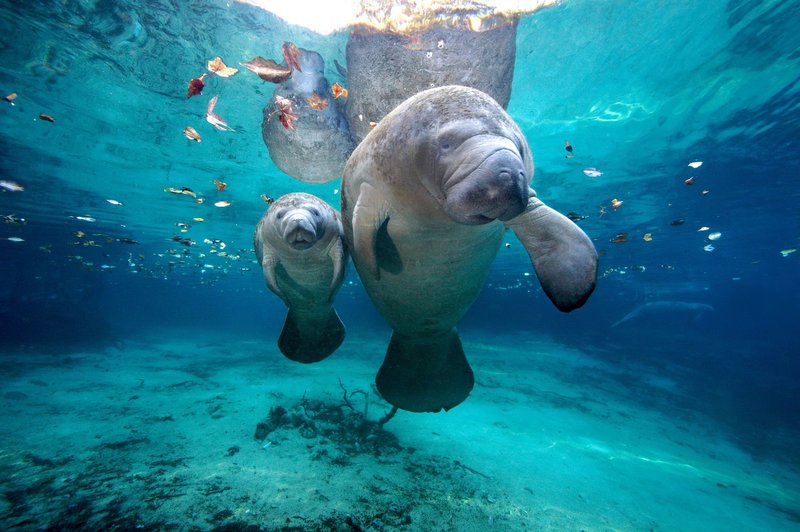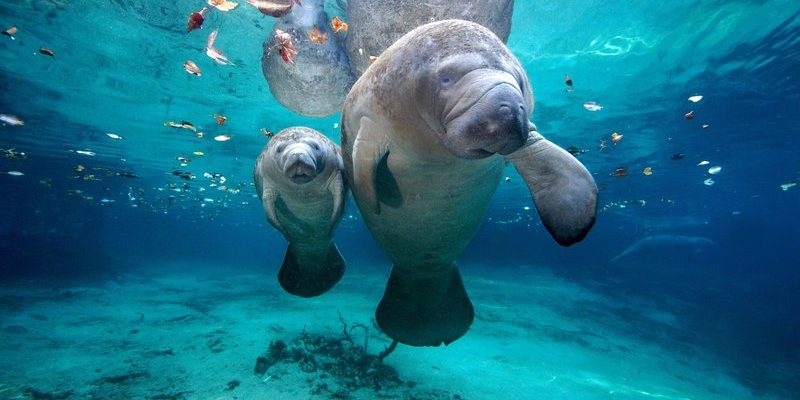
So, what makes manatees so well-suited to their aquatic lifestyle? Here’s the thing: manatees have developed some unique features that allow them to navigate and survive in underwater habitats. From their huge bodies to their specialized digestive systems, these adaptations are more than just cool facts—they’re vital for their survival. Let’s dive into the world of manatees and explore the adaptations that make these creatures remarkable.
Streamlined Bodies for Efficient Swimming
Manatees have large, round bodies that might make them look clumsy on land, but these shapes are perfect for life in the water. Their bodies are streamlined, meaning they’re designed to reduce resistance as they glide through the water. This helps them swim efficiently, using less energy, which is super important since they feed mainly on seagrass and need to conserve energy.
Their flippers, while not the same as fins, play a crucial role. They help manatees steer and navigate through their underwater environment. Picture a big ship turning gently through waves; that’s similar to how manatees use their flippers to change direction. With a tail that resembles a paddle, they can push themselves forward and maneuver with grace, even if they look a bit lumbering on the surface.
In essence, their body shape and flippers make them well-adapted for their environment. This streamlined design allows them to cover long distances while foraging for food, which is vital for their survival in shallow coastal areas.
Powerful Tails for Propulsion
Speaking of tails, manatees boast a large, paddle-shaped tail that’s vital for propulsion. Think of it as their engine. When they want to move quickly, they can swish that tail back and forth, propelling themselves through the water. This motion not only helps them swim but also allows them to stay agile amidst strong currents or when avoiding obstacles.
Their tails are incredibly strong, enabling them to maintain a steady course even in choppy waters. If you’ve ever tried to swim against a strong current, you know how challenging that can be. Manatees, with their powerful tails, are equipped to handle such difficulties, allowing them to migrate to different regions as the seasons change or find food sources.
It’s fascinating to see how a simple adaptation—a tail—can play such a significant role in a manatee’s life, helping them thrive in their underwater world.
Efficient Herbivores with Specialized Digestive Systems
Manatees are herbivores, meaning they primarily eat plants, mostly seagrass. But here’s an interesting twist: their digestive systems are specially adapted to break down tough plant material. This is important because it allows them to extract maximum nutrients from their food, even though they consume large quantities daily to meet their energy needs.
One remarkable feature of their digestion is their long intestines. In fact, a manatee’s intestinal tract can be up to 150 feet long! This helps them process all that seagrass efficiently, giving their bodies enough time to absorb nutrients. Imagine eating a salad that takes hours to digest; you’d want your body to use every bit of goodness from it, right? That’s how manatees process their food.
Additionally, manatees can consume up to 10% of their body weight in seagrass each day. With their specialized digestive systems, they can extract the vital nutrients needed to sustain their large bodies, ensuring they thrive in their watery homes.
Thick Skin for Protection
In the wild, manatees face various challenges, including potential predation and rough environments. To combat these threats, they have thick skin that offers some protection. This skin can be up to four inches thick in some areas, providing a barrier against injuries and environmental stresses.
Though they lack blubber like some marine mammals, their thick skin helps insulate them against temperature changes in the water. Manatees often inhabit warmer waters, but they can sometimes venture into cooler areas. Their skin keeps them warm enough to survive in varying conditions.
Moreover, this skin is covered in small hair-like structures called “vibrissae.” These tiny hairs are sensitive to touch and help manatees navigate their surroundings. It’s like having built-in sensors that alert them to nearby objects, which is vital when they’re foraging among seagrass beds or avoiding obstacles.
Strong Social Bonds
Manatees are not just solitary creatures; they often form strong social bonds with one another. These relationships are essential for their overall well-being. Being social helps them find food more efficiently, as they can share knowledge about the best feeding spots. Think of it as a community of friends gathering for a picnic—everyone benefits when they share.
Manatees are known to communicate through a series of sounds, such as chirps and whistles. This vocalization not only helps them maintain their social connections but can also alert others to potential dangers. Imagine being at a party and letting your friends know there’s a surprise guest; that’s how manatees share information within their groups.
Strong social bonds provide emotional support, especially since these creatures often face challenges in their natural habitat. A community that sticks together can navigate obstacles a lot more effectively than a lone traveler.
Adaptations for Breathing
Manatees are mammals, which means they need to breathe air, but they’ve adapted to their underwater lifestyle in remarkable ways. They can hold their breath for up to 20 minutes while diving or foraging, though they typically surface every 3 to 5 minutes for air. This ability to hold their breath allows them to stay submerged longer while searching for food.
To make sure they get all the oxygen they need, manatees have a nostril located on the top of their snouts. This adaptation lets them breathe efficiently as they swim near the surface. It’s similar to a snorkeler who only needs to poke their nose out of the water to take a breath. When they come up for air, they can simply lift their heads without much effort, allowing for a smooth transition between diving and breathing.
These adaptations underscore how manatees have evolved to fit seamlessly into their aquatic environments, showing that even the simplest aspects of their biology are perfectly suited to their lifestyle.
The adaptations that help manatees thrive underwater are truly remarkable. From their streamlined bodies and powerful tails to their specialized diets and social behaviors, these gentle giants have evolved in a way that showcases the beauty of nature. Each feature, no matter how small, contributes to their survival in intricate underwater habitats.
As we appreciate these adaptations, it’s important to remember the challenges manatees face in today’s world, such as habitat loss and climate change. Understanding how they thrive and what they need to survive can help us protect these incredible animals for future generations. Embracing the wonder of manatees not only enriches our knowledge but also strengthens our commitment to keeping their environments safe and healthy.

